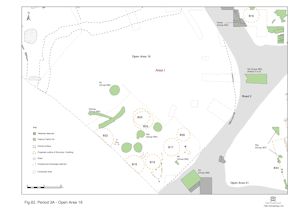
The gravel surface laid down in Period 2B within the interior of Open Area 18 remains in use and is apparently kept clean into the late 1st century AD, and perhaps beyond. While at least some of the Period 2B roundhouses probably continue to occupy the gravel surface early in Period 3, some clearly pass out of use and parts of the enclosure are encroached upon by pits (Figure 82).

Four pits (Group 594, 13640, 13717, 13771, 13824) are located in a band across the centre of Open Area 18. All are large and circular to oval in shape, generally 2.5m to 3m in diameter and in excess of 0.5m deep. Their spacing suggests that these are all broadly contemporary. Buildings 20, 21 and 23 certainly cannot co-exist with them. Buildings 17, 18, 19 and 26 lie to their south; Building 22 and Buildings 24 and 25 (the latter two being successive structures on the same plot) lie to their north. This spatial arrangement means that it is unclear whether the pits are contemporary with some of the buildings or not. There are two possibilities:
Of these pits, 13640 is perhaps notable for the ceramic phallus amulet (SF6093) it contains. Otherwise the contents of these pits appear to be of a purely domestic nature, comprising large amounts of pottery together with fragments of tile, loomweight, briquetage, animal bone and metalwork. The fill sequences of pits 13771 and 13824 seem to be only partially complete when subsequently overlain by the Period 3B dump deposits, the upper fills sharing both physical characteristics and dating with the layers above. All the pits yield large quantities of finds, with a broad range of artefact types that presumably reflects the nature of the surrounding occupation activities. The range of pottery forms present, supported by the coin and brooches in 13717 and 13640 and general absence of grog-tempered wares, strongly suggests that these pits are filled during the late 1st century AD. Pits 13717, 13771 and 13824 receive additional material in the form of BB2 dishes probably during the first half of the 2nd century - perhaps as part of a single levelling episode of the pock-marked enclosure land surface.
Two 'outlying' pits (Group 595, 13883, 18338) are also located within OA18. Pit 13883 is over 1m deep and cut into poorly draining natural brickearth. As a result, its lower fills are waterlogged and organic-rich, yielding fragments of leather as well as seeds, nuts, molluscs and beetles. This material indicates that the pit is standing in open ground, among nettles and short vegetation, and remains open and water-filled for a period of time. Remains of synanthropic insect species hint at the presence of human occupation and timber buildings in the near vicinity. Unfortunately, this pit, located as it is on the opposite side of plot boundary ditch 25120 and the other pits and roundhouses, in a part of OA18 that is otherwise almost wholly unexcavated, cannot necessarily be taken as indicative of activity in the roundhouse area itself.
Early Roman ditches 25120 and 25122 coincide with the north edge of the Period 2B gravel surface within Open Area 18 and may be a complementary addition to the roundhouse complex - perhaps marking its northern extent.
Shallow ditch 25120 (seg. 18204) is aligned roughly NNE-SSW. It has an irregularly shaped rounded terminal at its eastern end and extends beyond the western edge of excavation. This ditch probably represents a plot boundary or internal subdivision within OA18. It lies c. 26m from, and parallel with, the Road 2 frontage. It is possible that the terminal marks one side of an access between the two plots, a postulated eastern part perhaps extending across the open area to the edge of Road 1. Ditch 25120 (seg. 18204) contains a large ceramic assemblage, providing a late 1st century AD infilling date.
Underlying this ditch is slighter ditch 25122 (seg. 18358) that probably dates to this sub-period but cannot be interpreted meaningfully. It contains a late 1st to early 2nd century brooch (SF6476).
Internet Archaeology is an open access journal based in the Department of Archaeology, University of York. Except where otherwise noted, content from this work may be used under the terms of the Creative Commons Attribution 3.0 (CC BY) Unported licence, which permits unrestricted use, distribution, and reproduction in any medium, provided that attribution to the author(s), the title of the work, the Internet Archaeology journal and the relevant URL/DOI are given.
Terms and Conditions | Legal Statements | Privacy Policy | Cookies Policy | Citing Internet Archaeology
Internet Archaeology content is preserved for the long term with the Archaeology Data Service. Help sustain and support open access publication by donating to our Open Access Archaeology Fund.